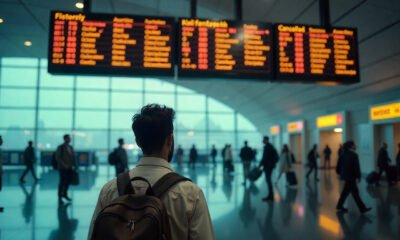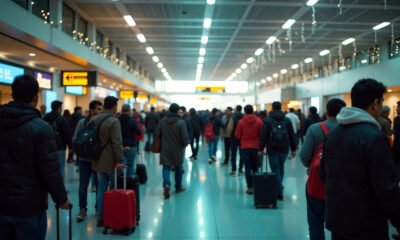Flight Buzz
Tshwane Moves to Relaunch Direct Passenger Flights from Pretoria’s Wonderboom Airport to Cape Town

Sunday, July 27, 2025
Tshwane is working to restart direct passenger flights between Wonderboom National Airport in Pretoria and Cape Town, with government-backed licensing and infrastructure upgrades underway. For travellers and residents, this change promises shorter journeys and greater convenience.
For people in Tshwane and beyond, the prospect of flying directly between Pretoria and Cape Town offers time saved, fewer hassles, and renewed regional opportunity.
Official Clearance: SACAA Upgrades Airport Licence
The South African Civil Aviation Authority (SACAA) reinstated Wonderboom Airport’s Category 5 aerodrome licence on August 8, 2023, restoring its eligibility to host scheduled commercial passenger services after years of non-compliance that led to downgrading in 2019 . Regulatory compliance gaps—such as runway markings, debris, lighting, and security—have since been addressed through systematic corrective measures.
Licensing Pathway: Air Service Licensing Council Review
Under the Air Service Licensing Act, 1990, the Air Service Licensing Council (ASLC)—under the Department of Transport—must approve any new domestic route application. As of mid-2025, applications to launch the Pretoria–Cape Town service are under review. However, SASAA’s return of council administration to the Department of Transport in October 2024 means the DoT now directly oversees licensing decisions.
Infrastructure Revival at Wonderboom
Tshwane’s city leadership has completed major upgrades at the airport: runway resurfacing, enhanced terminal facilities, improved lighting, security upgrades, and passenger lounges.
Historical Route & Airline Interest
In August 2015, Airlink launched thrice-daily flights between Pretoria and Cape Town using Avro RJ85 and Embraer ERJ135 aircraft. However, the service ended in May 2018 due to unprofitability, despite marketing efforts by Tshwane and joint venture with South African Airways.
Since then, the route has remained inactive but has remained a priority due to its potential for connectivity and public demand. Airlink has stated it remains open to resuming service when conditions improve.
Regional Economic Impact & Tourism Potential
Restoring this route is expected to benefit business travellers, government delegations, and tourists visiting both cities. Cape Town, as a major tourism hub, and Pretoria, as an administrative centre, generate steady demand.
Tourism stakeholders project stronger domestic travel flows between the two cities, enabling packaged travel that spans the administrative, cultural, and coastal attractions of South Africa. The relaunch aligns with national transport priorities outlined in the Department of Transport’s strategic roadmap.
Planning & Public Engagement
The Department of Transport began soliciting public comments on the route application under the Licensing Council process. Meanwhile, Tshwane officials continue to engage stakeholders in examining the business case, and assess potential airline partners to resume the route under sound financial models. The DoT has also digitised air service licence submission via email and online portals, streamlining processing and oversight
Looking Ahead: Scaling the Relaunch
If licenses are granted, airlines may initially propose 2–3 weekly flights, scaling based on demand. As domestic demand builds, the route could evolve into daily service. Transport authorities and city stakeholders are optimistic this route will eventually ease congestion at OR Tambo International Airport and provide a more localized alternative for Tshwane-based travellers.
Conclusion
In simple words: Tshwane is working with national aviation regulators to restart passenger flights between Wonderboom Airport in Pretoria and Cape Town, backed by license upgrades and infrastructure investments. The move promises stronger domestic connectivity, tourism growth, and economic vitality for the region. For local travellers and industries, it’s a welcomed shift toward better, faster, and more accessible air travel.
Flight Buzz
Trip.com Group’s Sustainability Initiative: CO₂ Emission Data for Flights, Car Rentals And Transfers Across Global Destinations

Monday, July 28, 2025
In a major step towards sustainability in travel, the Trip.com Group, a global leader in travel services, has launched a new feature providing quantified CO₂ emissions data for essential modes of transport, including flights, car rentals, airport transfers, and trains (in Europe). This initiative spans numerous global destinations, making it easier for travelers to make environmentally conscious decisions as they book their trips worldwide.
With the introduction of this new feature, users can now access detailed information on CO₂ emissions for rental cars listed on the Trip.com platform. Thanks to collaboration with the Association of Car Rental Industry System Standards (ACRISS), the platform allows travelers to compare emissions from electric, hybrid, and conventional vehicles. This addition empowers travelers to choose eco-friendly options for their rental car needs, helping minimize their carbon footprint across various global destinations.
In addition to rental cars, the CO₂ emission data for airport transfers has been incorporated. This allows travelers to evaluate and select the most environmentally friendly transportation options for each leg of their journey, ensuring greener travel experiences at global destinations. The new feature, detailed in the latest sustainability report from Trip.com Group, also highlights significant progress in promoting eco-consciousness in the travel industry.
Trip.com Group’s Broader Commitment to Sustainability
The Trip.com Group’s sustainability efforts are broad and multifaceted, aligning with its overarching goal to become CO₂-neutral by 2050. As part of their “Friendly-Four” concept community-friendly, family-friendly, eco-friendly, and stakeholder-friendly Trip.com is intensifying its initiatives in each of these areas. The sustainability report highlights key achievements such as the company’s push to encourage over 100 million bookings for sustainable travel products in 2024, which marks a significant commitment to reducing the environmental impact of tourism.
The company also continued to integrate renewable energy into its operations. Notably, the solar panels installed at its headquarters and on the so-called “land houses” generated a clean 457 MWh of electricity in 2024. This move significantly reduced the carbon footprint associated with its business operations. In addition, the Trip.com Group has taken steps to measure and report on all Scope-3 emissions, which include indirect greenhouse gas emissions from sources like rented data centers and business travel, enhancing the company’s sustainability accountability.
Expanding the “Land House” Program for Sustainable Tourism Development
Another key area of Trip.com Group’s sustainability focus is its contribution to rural development through tourism. The company’s flagship “Land House” program has expanded to 34 locations, creating over 40,000 indirect jobs and providing substantial economic benefits to local communities. More than 80% of employees at these land houses are local residents, and the villages participating in the program have experienced an average increase of $5,500 in per capita income.
This year, the “Land House” program is set to expand further to additional global destinations, continuing its role in fostering sustainable tourism and economic development in rural regions. By combining sustainable travel with local economic empowerment, the program plays a crucial part in Trip.com Group’s strategy to create a positive environmental and social impact.
Family-Friendly Initiatives and Corporate Social Responsibility
Trip.com Group is also strengthening its position as a leading family-friendly employer. With women representing 57.1% of the global workforce, the company has made notable strides in gender equality, with 32.7% of upper and middle management roles held by women. Additionally, the company has prioritized work-life balance through its hybrid work model, which has been adopted over 630,000 times by employees to date. This initiative has saved an estimated 1.25 million commuting hours, helping employees balance their professional and personal lives more effectively.
As part of its commitment to supporting families, Trip.com Group introduced three additional days of childcare leave in April 2024. This initiative is designed to help working parents better balance their personal and professional commitments. Furthermore, the company’s childcare subsidy program, introduced in 2023, has already provided financial support for over 900 children, with more than $468,000 distributed in 2024 alone.
Corporate Governance and Future Commitment to Sustainability
The Trip.com Group has also made significant advancements in corporate governance, earning an “A” rating from MSCI ESG. This rating reflects the company’s efforts to enhance transparency and foster sustainable practices across its operations. The company’s strong focus on responsible corporate practices and its ongoing partnerships with more than 230 destination marketing organizations highlight its commitment to promoting inclusive tourism development.
Trip.com Group’s sustainability strategy continues to evolve, with a clear emphasis on long-term commitment to environmental, social, and governance (ESG) principles. By offering travelers access to CO₂ emissions data for key transport modes, expanding rural tourism programs, and strengthening its family-friendly policies, the company is working to ensure that sustainable travel is both accessible and impactful across global destinations.
The company’s continued focus on these efforts underscores the growing importance of sustainability in the travel industry and positions the Trip.com Group as a key player in shaping a greener, more inclusive future for tourism worldwide.
Flight Buzz
Asiana Airlines Slashes Flights Between South Korea and United States for Winter 2025 – What You Should Know Now

Sunday, July 27, 2025
Asiana Airlines (OZ) will reduce frequencies of flights between South Korea and the United States for the winter 2025 season. The cutbacks, which primarily affect service to San Francisco and Seattle, are part of the airline’s push to better deploy its fleet and improve its operations.
The biggest cut will be for the Seoul–San Francisco (SFO) line, with the airline bringing down capacity by half. Over the period November 2025 to December 2025, Asiana’s schedule will see 5 flights a week between Seoul Incheon International Airport and San Francisco. Flights to Seattle-Tacoma International Airport (SEA) will also be reduced by 20% in September and October 2025.
Reduced Transpacific Services
Asiana Airlines has long been a key player in transpacific air travel, with well-established routes connecting Seoul to major U.S. cities. The ICN–SFO route, in operation since the early 1990s, is currently served by the Airbus A350-900, which offers 311 seats across three classes.
For winter 2025 the airline will offer only five flights a week between Seoul and San Francisco, flying 4,917 nautical miles (9,106 km) taking 11 hours approximately. This loss is symptomatic of broader shifts in the airline’s transpacific approach. Other airlines on the route are Korean Air, United Airlines and Air Premia.
Asiana‘s ICN–SEA meanwhile will drop from seven to five weekly for September and October 2025. The Boeing 777-200ER is commonly used for these international flights, with the capacity to seat 300 passengers, in two classes. The journey spans 4,533 nautical miles (8,394 km) and lasts approximately 10.5 hours.
Fleet and Competitive Landscape
Asiana Airlines operates a fleet of 15 Airbus A350-900s, with a further 15 on order. The Dreamliners are deployed on long-haul routes and have a configuration of 28 business class, 36 premium economy and 247 economy seats. Asiana operates 22 business class and 278 economy seats on the Seattle route, which it says represents its smallest long-haul aircraft, among the nine used for the route alongside other destinations.
Even with such cuts, the routes are competitive. Korean Air, Delta Air Lines and Air Premia also have flights between South Korea and the U.S. West Coast. Alaska Airlines will also launch nonstop service between Seattle and Seoul in September 2025 in collaboration with Hawaiian Airlines to make the competition fiercer.
The Korean Air–Asiana Merger
The flight reductions are being done in parallel with the continued combination of Asiana Airlines and state-controlled Korean Air, a tie-up approved by the South Korean government in 2020. In December 2024, Korean Air purchased a controlling stake in Asiana and became a subsidiary. It is anticipated that the combination will be fully effective by December 2026.
They expect that project will allow for the reduction of 22 flights, including Seoul- Ho Chi-Minh City, Seoul -Jakarta and Seoul-Istanbul. The two carriers currently have large hubs in Seoul Incheon International Airport and the merger is designed to increase efficiency and enhance competitiveness. Korean Air has promised not to lay off any staff during the integration.
Impact on U.S.–South Korea Travel
The service reductions suggest a change of strategy at Asiana in transpacific flying, possibly due to efforts to right-size its fleet or reorganize its network. Although the cuts may reduce choices for passengers in the short term, the goal in the long term is to operate more efficiently.
Passengers traveling to or from the U.S. and South Korea will want to stay aware of these developments, with more schedule changes, fleet shifts and market dynamics inevitable as the Korean Air-Asiana integration unfolds. The changing landscape will alter the U.S.-South Korea air travel game for years to come.
Flight Buzz
First direct commercial flight launched between Russia and North Korea

Russia has inaugurated a new regular air service between Moscow and Pyongyang, a development underscoring the deepening relationship between the two nations.
The inaugural flight, operated by Russian carrier Nordwind, departed Moscow’s Sheremetyevo airport on Sunday with more than 400 passengers aboard. Russia’s Transport Ministry confirmed plans for one monthly flight to accommodate demand.
Russian Foreign Minister Sergey Lavrov, who visited North Korea‘s new Wonsan-Kalma beach resort earlier this month to meet with North Korean leader Kim Jong Un, promised to encourage Russian tourists to visit the complex.
The resort, which can accommodate nearly 20,000 people, is at the center of Kim’s push to boost tourism to improve his country’s troubled economy.
North Korea has been slowly easing the curbs imposed during the pandemic and reopening its borders in phases. But the country hasn’t said if it would fully resume international tourism.
Regular flights between Russia’s eastern port city of Vladivostok and Pyongyang reopened in 2023 following a break caused by the coronavirus pandemic.
Russia and North Korea have sharply expanded military and other ties in recent years, with Pyongyang supplying weapons and troops to back Russia’s military action in Ukraine.
-

 Brand Stories6 days ago
Brand Stories6 days agoBloom Hotels: A Modern Vision of Hospitality Redefining Travel
-

 Brand Stories2 days ago
Brand Stories2 days agoCheQin.ai sets a new standard for hotel booking with its AI capabilities: empowering travellers to bargain, choose the best, and book with clarity.
-

 Destinations & Things To Do1 week ago
Destinations & Things To Do1 week agoUntouched Destinations: Stunning Hidden Gems You Must Visit
-

 AI in Travel1 week ago
AI in Travel1 week agoAI Travel Revolution: Must-Have Guide to the Best Experience
-

 Brand Stories3 weeks ago
Brand Stories3 weeks agoVoice AI Startup ElevenLabs Plans to Add Hubs Around the World
-

 Brand Stories2 weeks ago
Brand Stories2 weeks agoHow Elon Musk’s rogue Grok chatbot became a cautionary AI tale
-

 Destinations & Things To Do1 day ago
Destinations & Things To Do1 day agoThis Hidden Beach in India Glows at Night-But Only in One Secret Season
-

 Asia Travel Pulse3 weeks ago
Asia Travel Pulse3 weeks agoLooking For Adventure In Asia? Here Are 7 Epic Destinations You Need To Experience At Least Once – Zee News
-

 AI in Travel3 weeks ago
AI in Travel3 weeks ago‘Will AI take my job?’ A trip to a Beijing fortune-telling bar to see what lies ahead | China
-

 Brand Stories3 weeks ago
Brand Stories3 weeks agoChatGPT — the last of the great romantics













You must be logged in to post a comment Login